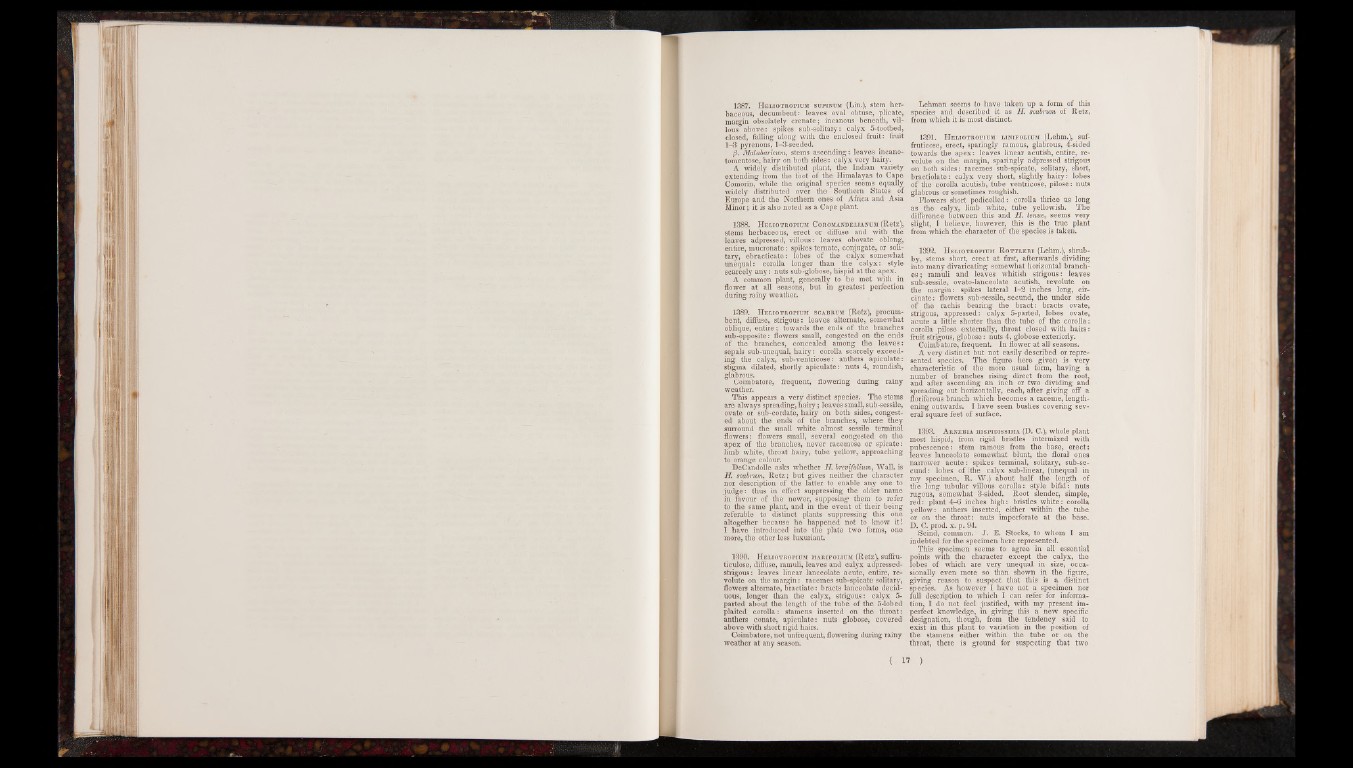
1387. H eliotropium supinum (Lin.), stem herbaceous,
decumbent: leaves oval obtuse, plicate,
margin obsolately crenate; incanous beneath, villous
above: spikes sub-solitary: calyx 5-toothed,
closed, falling along with the enclosed fruit: fruit
1-3 pyrenons, 1-3-seeded.
6. Malabaricum, stems ascending: leaves incano-
tomentose, hairy on both sides: calyx very hairy.
A widely distributed plant, the Indian variety
extending from the foot of the Himalayas to Cape
Comorin, while the original species seems equally
widely distributed over the Southern States of
Europe and the Northern ones of Africa and Asia
Minor; it is also noted as a Cape plant.
1388. H eliotropium Coromandelianum (Retz),
stems herbaceous, erect or diffuse and with the
leaves adpressed, villous: leaves obovate oblong,
entire, mucronate: spikes temate, conjugate, or solitary,
ebracticate: lobes of the calyx somewhat
unequal: corolla longer than the calyx: style
scarcely any: nuts sub-globose, hispid at the apex.
A common plant, generally to be met with in
flower at all seasons, but in greatest perfection
during rainy weather.
1389. Heliotropium scabrum (Retz), procumbent,
diffuse, strigous: leaves alternate, somewhat
oblique, entire; towards the ends of the branches
sub-opposite: flowers small, congested on the ends
of the branches, concealed among the lea v e s:
sepals sub-unequal, hairy: corolla scarcely exceeding
the calyx, sub-ventricose: anthers apiculate:
stigma dilated, shortly apiculate: nuts 4, roundish,
glabrous.
Coimbatore, frequent, flowering during rainy
weather.
This appears a very distinct species. The stems
are always spreading, hairy; leaves small, sub-sessile,
ovate or sub-cordate, hairy on both sides, congested
about the ends of the branches, where they
surround the small white almost sessile terminal
flowers: flowers small, several congested on the
apex of the branches, never racemose or spicate:
limb white, throat hairy, tube yellow, approaching
to orange colour.
DeCandolle asks whether H. brevifolimn, Wall, is
H. scabrum, Retz; but gives neither the character
nor description of the latter to enable any one to
judge: thus in effect suppressing the older name
in favour of the newer, supposing them to refer
to the same plant, and in the event of their being
referable to distinct plants suppressing this one
altogether because he happened not to know it!
I have introduced into the plate two forms, one
more, the other less luxuriant.
1390. Heliotropium maripolium (Retz), suffru-
ticulose, diffuse, ramuli, leaves and calyx adpressed-
strigous: leaves linear lanceolate acute, entire, revolute
on the margin: racemes sub-spicate solitary,
flowers alternate, bractiate: bracts lanceolate deciduous,
longer than the calyx, strigous: calyx 5-
parted about the length of the tube of the 5-lobed
plaited corolla: stamens inserted on the throat:
anthers conate, apiculate: nuts globose, covered
above with short rigid hairs.
Coimbatore, not unfrequent, flowering during rainy
weather at any season.
Lehman seems to have taken up a form of this
species and described it as H scabrum of Retz,
from which it is most distinct.
1393. Heliotropium linifolium (Lehm.), suf-
fruticose, erect, sparingly ramous, glabrous, 4-sided
towards the apex: leaves linear acutish, entire, revolute
on the margin, sparingly adpressed strigous
on both sides: racemes sub-spicate, solitary, short,
bractiolate: calyx very short, slightly hairy: lobes
of the corolla acutish, tube ventncose, pilosè: nuts
glabrous or sometimes roughish.
Flowers short pedicelled: corolla thrice as long
as the calyx, limb white, tube yellowish. The
difference between this and H. tenue, seems very
slight, I believe, however, this is the true plant
from which the character of the species is taken.
3392. H eliotropium R ottleri (Lehm.), shrubby,
stems short, erect at first, afterwards dividing
into many divaricating somewhat horizontal branches
; ramuli and leaves whitish strigous : leaves
sub-sessile, ovato-lanceolate acutish, revolute on
the margin: spikes lateral 1 -2 inches long, eir-
cinate : flowers sub-sessile, secund, the under side
of the rachis bearing the bract : bracts ovate,
strigous, appressed: calyx 5-parted, lobes ovate,
acute a little shorter than the tube of the corolla:
corolla pilose externally, throat closed with hairs:
fruit strigous, globose : nuts 4, globose exteriorly.
Coimbatore, frequent. In flower at all seasons.
A very distinct but not easily described or represented
species. The figure here given is very
characteristic of the more usual form, having a
number of branches rising direct from the root,
and after ascending an inch or two dividing and
spreading out horizontally, each, after giving off a
floriferous branch which becomes a raceme, lengthening
outwards. I have seen bushes covering several
square feet of surface.
1393. Arnebia hispidissima (D. C.), whole plant
most hispid, from rigid bristles intermixed with
pubescence: stem ramous from the base, erect:
leaves lanceolate somewhat blunt, the floral ones
narrower acute: spikes terminal, solitary, sub-se-
cund : lobes of {the calyx sub-linear, (unequal in
my specimen, R. W.) about half the length of
the long tubular villous corolla: style bifid: nuts
rugous, somewhat 3-sided. Root slender, simple,
red: plant 4 -6 inches high: bristles white: corolla
yellow: anthers inserted, either within the tube
or on the throat: nuts imperforate at the base.
D. C. prod. x. p. 94.
Scind, common. J. E. Stocks, to whom I am
indebted for the specimen here represented.
This specimen seems to agree in all essential
points with the character except the calyx, the
lobes of which are very unequal in size, occasionally
even more so than shown in the figure,
giving reason to suspect that this is a distinct
species. As however I have not a specimen nor
full description to which I can refer for information,
I do not feel justified, with my present imperfect
knowledge, in giving this a new specific
designation, though, from the tendency said to
exist in this plant to variation in the position of
the stamens either within the tube or on the
throat, there is ground for suspecting that two